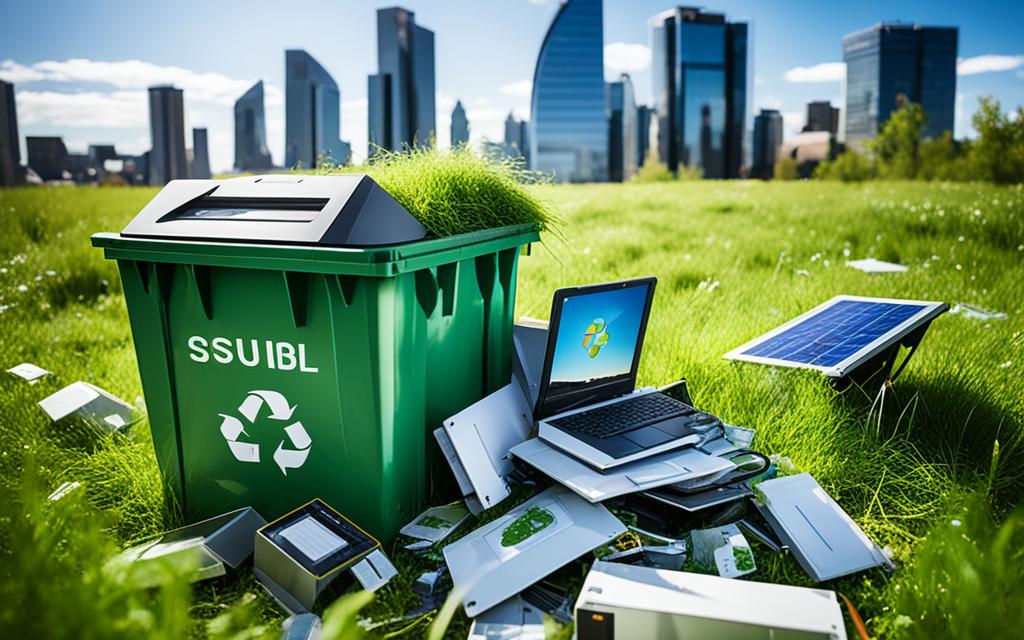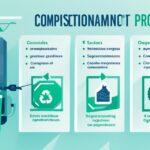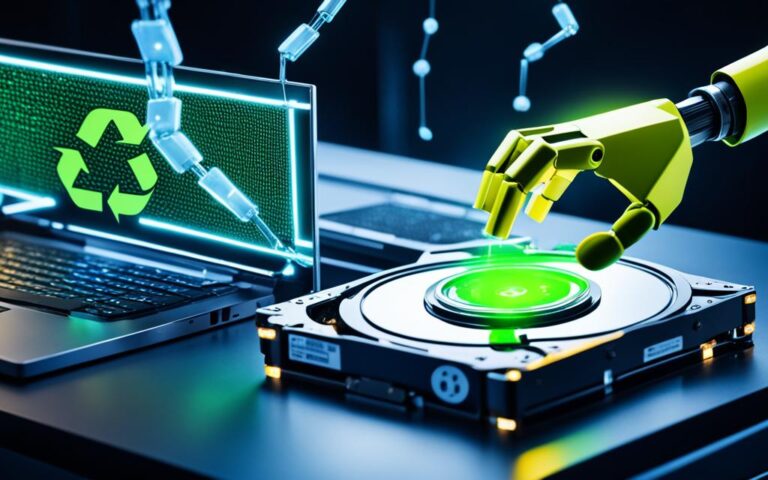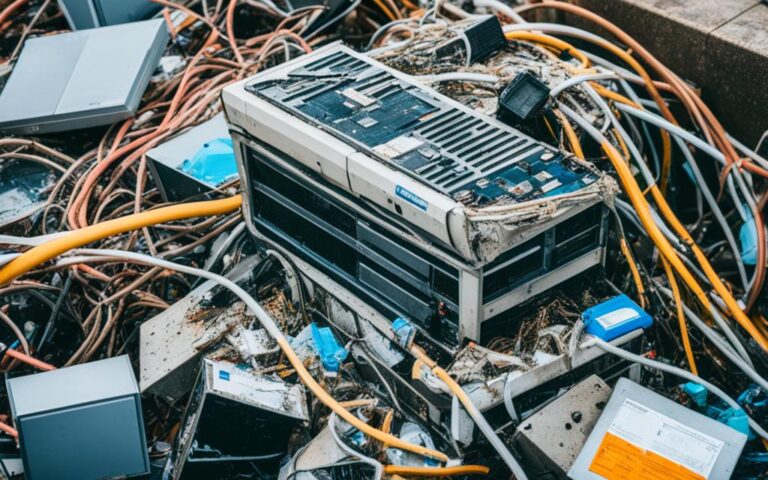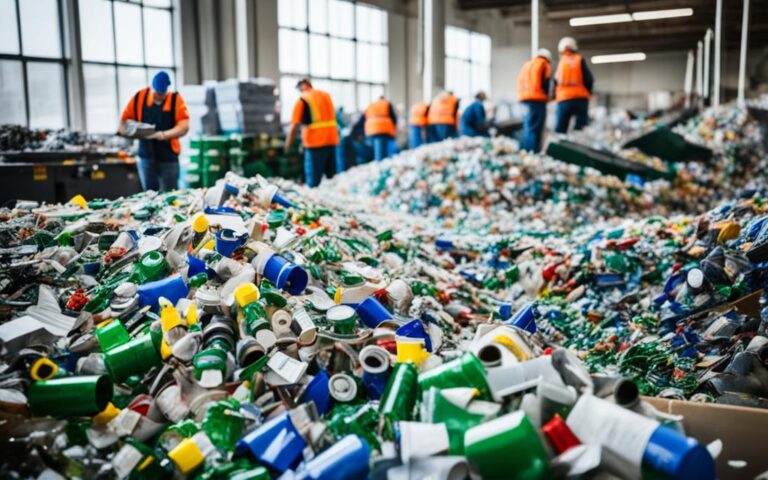Crafting a Greener Tomorrow: Eco-Disposal of PCs
Disposing of old computers and other IT equipment is a task that requires careful consideration, especially in terms of its environmental impact. To ensure a greener tomorrow, it is crucial for UK businesses to prioritize corporate eco-disposal and sustainable PC recycling.
Improper disposal of IT equipment not only poses risks to data security but also contributes to electronic waste, further damaging the environment. It is important to adhere to the regulations in the UK that prohibit throwing IT equipment in landfills.
When preparing a computer for disposal, several steps should be taken to ensure secure data deletion and minimize the environmental impact. These include creating a backup of important data, properly cleaning the hard drive to ensure data is irrecoverable, wiping external drives, deleting browsing history, uninstalling programs, and encrypting all files if necessary.
One option to consider for eco-friendly IT asset disposal is Corporate Eco-Disposal. They offer tailored services to meet the needs of UK businesses, providing secure data wiping and proper disposal methods. By collaborating with Corporate Eco-Disposal, businesses can play their part in reducing electronic waste and promoting sustainability.
By embracing corporate eco-disposal and sustainable PC recycling, UK businesses can contribute to a greener tomorrow. Let’s work together to protect the environment and build a sustainable future.
Understanding IT Equipment Recycling
When it comes to IT equipment disposal, recycling plays a crucial role in reducing the environmental impact of electronic waste. IT equipment recycling involves the disassembling and separation of computer components and raw materials, promoting sustainable practices and resource conservation.
However, IT equipment recycling goes beyond simply disposing of old computers. It encompasses various disposal etiquettes such as reusing, donating, and repairing old equipment to extend their lifespan and reduce waste. Emphasizing these practices ensures a more sustainable approach to IT asset disposal.
Disposing of a computer is the last step in the waste hierarchy, which is a prioritized approach to waste management that aims to minimize environmental impact. It is important to understand how to prepare a computer for disposal to ensure the secure deletion of data and compliance with regulations, such as the Waste Electrical and Electronic Equipment (WEEE) Directive in the UK.
The Waste Hierarchy
The waste hierarchy provides a framework for responsible and sustainable waste management. It prioritizes waste management practices based on their environmental impact, with disposal being the last resort. Here is an overview of the waste hierarchy:
- Prevention: Reducing waste generation and promoting eco-design.
- Minimization: Minimizing waste production through efficient processes and resource optimization.
- Reuse: Extending the lifespan of products by reusing them in their current form.
- Recycling: Recovering and recycling materials from products and turning them into new ones.
- Energy recovery: Using waste as a source of energy through processes like incineration with energy generation.
- Disposal: Safe and responsible disposal of waste that cannot be prevented, minimized, or recovered.
Recycling, donating, and trading IT equipment are alternative options to consider within the waste hierarchy. By choosing these options, businesses and individuals can contribute to reducing electronic waste and conserving valuable resources. Sustainable disposal practices also support the circular economy by promoting resource efficiency.
| Benefits of IT Equipment Recycling | Ways to Recycle IT Equipment |
|---|---|
| Reduces electronic waste | Donate to charities or educational institutions |
| Conserves valuable resources | Trade-in programs with technology vendors |
| Prevents hazardous substances from entering the environment | Engage with specialized IT asset disposal companies |
| Promotes the circular economy | Recycle through certified e-waste recycling facilities |
Remember, responsible IT equipment recycling not only helps protect the environment but also ensures secure data deletion and compliance with regulations. By opting for recycling and other sustainable disposal methods, you can contribute to a greener future while making a positive impact on your business and the community.
The Benefits of Green Computing
Green computing, also known as Green Technology or Green IT, is the environmentally responsible and eco-friendly use of computers and their resources. It aims to reduce the carbon footprint generated by the Information Technology and Systems business and promote sustainability. Green computing involves using energy-efficient devices, reducing waste, and practicing responsible IT asset disposal. It benefits the environment by reducing energy consumption, minimizing electronic waste, and contributing to the overall goal of environmental sustainability.
Energy Efficiency
The use of energy-efficient devices is a key aspect of green computing. Energy-efficient computers, servers, and peripherals consume less power, resulting in reduced electricity usage. This not only saves costs but also reduces the demand for electricity, leading to lower greenhouse gas emissions and a smaller carbon footprint. For example, companies like Dell have introduced energy-efficient components and power management features in their products to promote greener computing practices.
Waste Reduction
Another important aspect of green computing is reducing waste. Minimizing electronic waste is crucial for environmental sustainability. This can be achieved through various strategies such as extending the lifespan of devices, reusing components, and recycling. Companies like Apple have implemented recycling programs where customers can return their old devices to be responsibly disposed of or refurbished. By reusing and recycling IT equipment, we can reduce the amount of electronic waste that ends up in landfills and contribute to a more sustainable future.
Sustainable Practices
In addition to energy efficiency and waste reduction, green computing promotes overall sustainability. It encourages businesses and individuals to adopt practices that minimize their environmental impact. This includes using cloud computing to reduce the need for physical infrastructure, opting for virtual meetings instead of traveling, and implementing power management techniques such as putting devices into sleep mode when not in use. By incorporating these sustainable practices into our computing habits, we can make a significant difference in preserving the environment.
Quote:
“Green computing is not just about using energy-efficient devices; it’s also about adopting a holistic approach towards responsible IT asset disposal and sustainable practices that benefit the environment.” – Mark Smith, IT Sustainability Expert
| Benefits of Green Computing | Description |
|---|---|
| Reduced Energy Consumption | Energy-efficient devices consume less power, resulting in reduced electricity usage and lower carbon footprint. |
| Minimized Electronic Waste | By reusing and recycling IT equipment, electronic waste can be significantly reduced, contributing to a more sustainable future. |
| Cost Savings | Energy-efficient devices and sustainable practices can result in cost savings on electricity bills and equipment purchases. |
| Improved Corporate Image | Adopting green computing practices demonstrates corporate social responsibility and can enhance the company’s reputation. |
| Long-term Sustainability | Green computing promotes sustainable practices that have long-term benefits for the environment and future generations. |
The Importance of Responsible IT Asset Disposal
Research estimates that the ICT sector’s carbon footprint accounts for 1.4% of overall global emissions and is the fastest-growing. Inefficient or non-existent processes for handling redundant IT equipment can hinder progress and contribute to environmental pollution. Responsible IT asset disposal is crucial in reducing carbon emissions and minimizing electronic waste. Improper disposal can also pose risks to data security. It is important for organizations to have a responsible IT asset disposal strategy in place to ensure secure data wiping, promote sustainability, and support environmental initiatives.
A responsible IT asset disposal strategy not only mitigates the environmental impact of electronic waste but also helps in reducing CO2 emissions resulting from the manufacturing and transportation of new IT equipment. By securely disposing of old and unused IT assets through proper channels, businesses can avoid contributing to the growing electronic waste crisis and minimize their carbon footprint.
In addition to the environmental benefits, responsible IT asset disposal ensures the secure disposal of sensitive data. In a world where data breaches and identity theft are significant concerns, organizations must prioritize secure data disposal to protect their customers, employees, and business reputation. Proper data wiping techniques and destruction processes ensure that all confidential information is irretrievable, reducing the risk of data breaches.
A responsible IT asset disposal strategy typically involves partnering with certified IT asset disposal service providers. These providers have the expertise and knowledge to handle IT equipment disposal in a secure and environmentally friendly manner. They follow industry best practices, adhere to legal and regulatory requirements, and employ secure data wiping methods to safeguard sensitive information.
By adopting responsible IT asset disposal practices, businesses can make a positive impact on the environment, reduce their carbon emissions, and safeguard their data. It is an essential step towards adopting sustainable business practices and contributing to a greener future.
The Risks of Improper IT Asset Disposal
Improper IT asset disposal poses significant risks to both the environment and data security. When IT equipment is not disposed of responsibly, it often ends up in landfills where hazardous materials can leach into the soil and water, causing pollution and harm to ecosystems. Electronic waste contains toxic substances such as lead, mercury, and cadmium, which can have long-term detrimental effects on the environment and human health.
From a data security perspective, improper disposal can lead to sensitive information falling into the wrong hands. Simply deleting files or formatting a hard drive is not enough to ensure data is irrecoverable. Sophisticated data recovery techniques can retrieve information from improperly disposed IT equipment, putting individuals and businesses at risk of data breaches, identity theft, and financial loss.
Best Practices for Responsible IT Asset Disposal
When it comes to responsible IT asset disposal, following best practices is crucial to ensure environmental sustainability and data security. Here are some key steps to take:
- Assess the equipment: Evaluate the IT equipment to determine if it can be reused, donated, or recycled. If it is no longer usable, proper disposal is necessary.
- Secure data wiping: Use certified data wiping software or seek professional help to ensure that all data is completely and securely erased from the equipment. This step is vital to protect sensitive information and comply with data protection regulations.
- Environmentally friendly recycling: If the equipment cannot be reused or donated, opt for environmentally friendly recycling services. Certified recyclers will dismantle the equipment, recover valuable materials, and dispose of hazardous substances safely.
- Documentation: Keep records of the disposal process, including evidence of data wiping and recycling certificates. This documentation helps demonstrate compliance with legal and regulatory requirements.
By following these best practices, businesses can ensure responsible IT asset disposal and contribute to a more sustainable and secure future.
Conclusion
The proper disposal of IT equipment plays a vital role in achieving sustainability goals and reducing the environmental impact of electronic waste. To craft a greener tomorrow, organizations must implement eco-friendly practices such as secure data deletion, the use of energy-efficient devices, and responsible IT asset disposal.
By partnering with companies like Corporate Eco-Disposal, businesses can ensure the secure and environmentally-friendly end-of-life management of their IT equipment. This not only helps organizations meet their sustainability targets but also contributes to the overall effort of protecting the environment.
Together, we can make a difference by embracing eco-friendly practices and adopting responsible IT asset disposal strategies. Let’s prioritize sustainability, minimize our environmental impact, and pave the way for a brighter and more sustainable future.
FAQ
What is Corporate Eco-Disposal?
Corporate Eco-Disposal is a company that offers eco-friendly IT asset disposal services tailored to the needs of UK businesses. They provide secure data wiping and proper disposal methods to minimize the environmental impact of IT equipment.
Why is proper disposal of IT equipment important?
Proper disposal of IT equipment is essential for achieving sustainability goals and reducing the environmental impact of electronic waste. It helps in reducing carbon emissions and minimizing electronic waste, while also ensuring secure data deletion and compliance with regulations.
What are the options for IT equipment disposal?
The options for IT equipment disposal include recycling, donating, and trading. These alternative options help in minimizing electronic waste and promoting sustainability.
How can I prepare a computer for disposal?
To prepare a computer for disposal, it’s important to create a backup of important data, clean the hard drive properly to ensure data is irrecoverable, wipe external drives, delete browsing history, uninstall programs, encrypt all files if necessary, and consider options such as recycling, donating, or trading the equipment.
What is IT equipment recycling?
IT equipment recycling involves the disassembling and separation of computer components and raw materials. It encompasses the proper disposal etiquettes of reusing, donating, and repairing old computers and other equipment.
What is green computing?
Green computing, also known as Green Technology or Green IT, is the environmentally responsible and eco-friendly use of computers and their resources. It aims to reduce the carbon footprint generated by the Information Technology and Systems business and promotes sustainability.
How does green computing benefit the environment?
Green computing benefits the environment by reducing energy consumption, minimizing electronic waste, and contributing to the overall goal of environmental sustainability.
What is the carbon footprint of the ICT sector?
Research estimates that the ICT sector’s carbon footprint accounts for 1.4% of overall global emissions and is the fastest-growing. It is crucial to have responsible IT asset disposal strategies in place to reduce carbon emissions and minimize electronic waste.
How can responsible IT asset disposal support environmental initiatives?
Responsible IT asset disposal supports environmental initiatives by ensuring secure data wiping, promoting sustainability, and minimizing the environmental impact of IT equipment.
How can partnering with Corporate Eco-Disposal help?
By partnering with Corporate Eco-Disposal, businesses can ensure the secure and environmentally friendly disposal of their IT equipment. Together, we can make a difference in protecting the environment and building a sustainable future.

